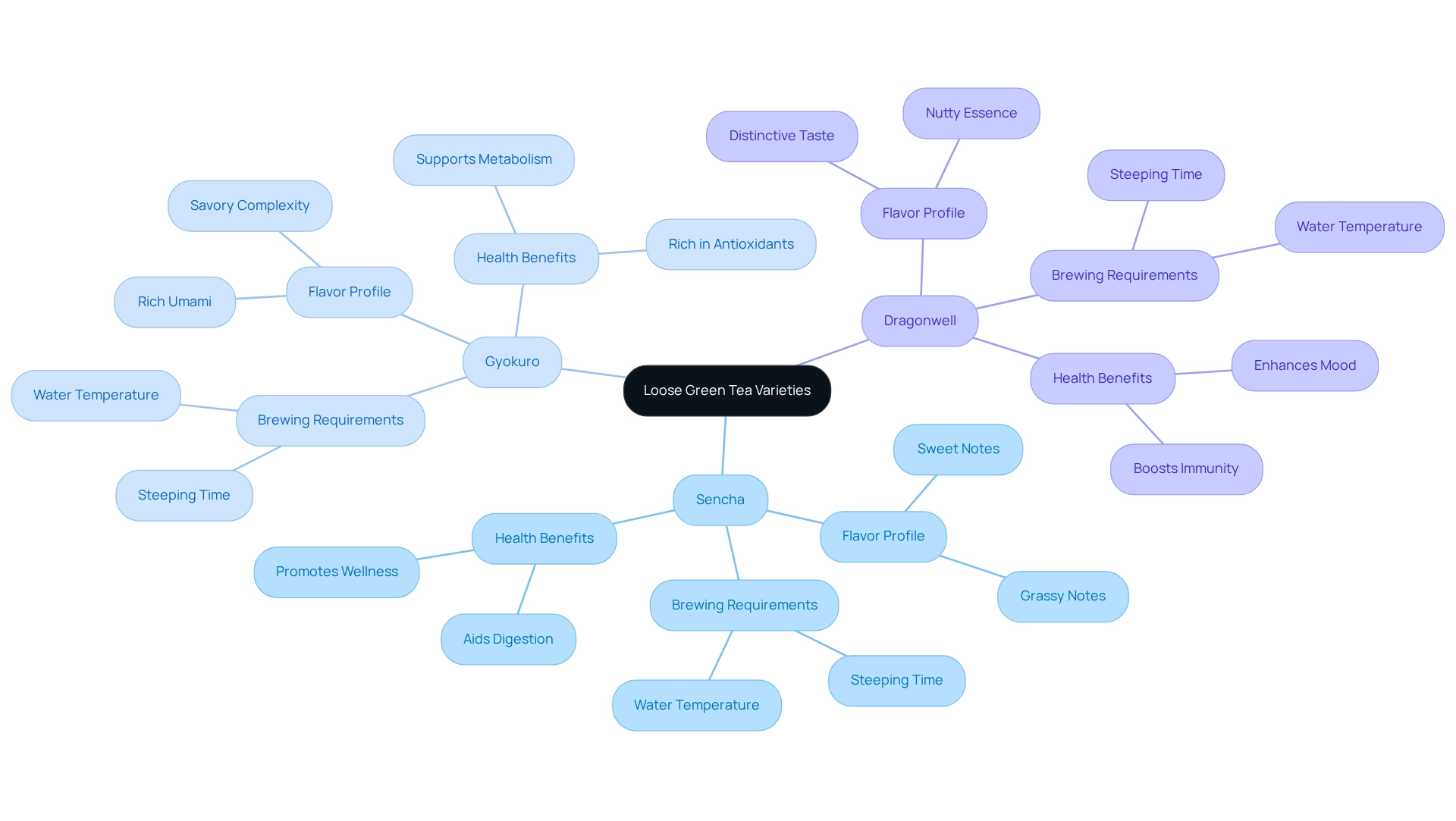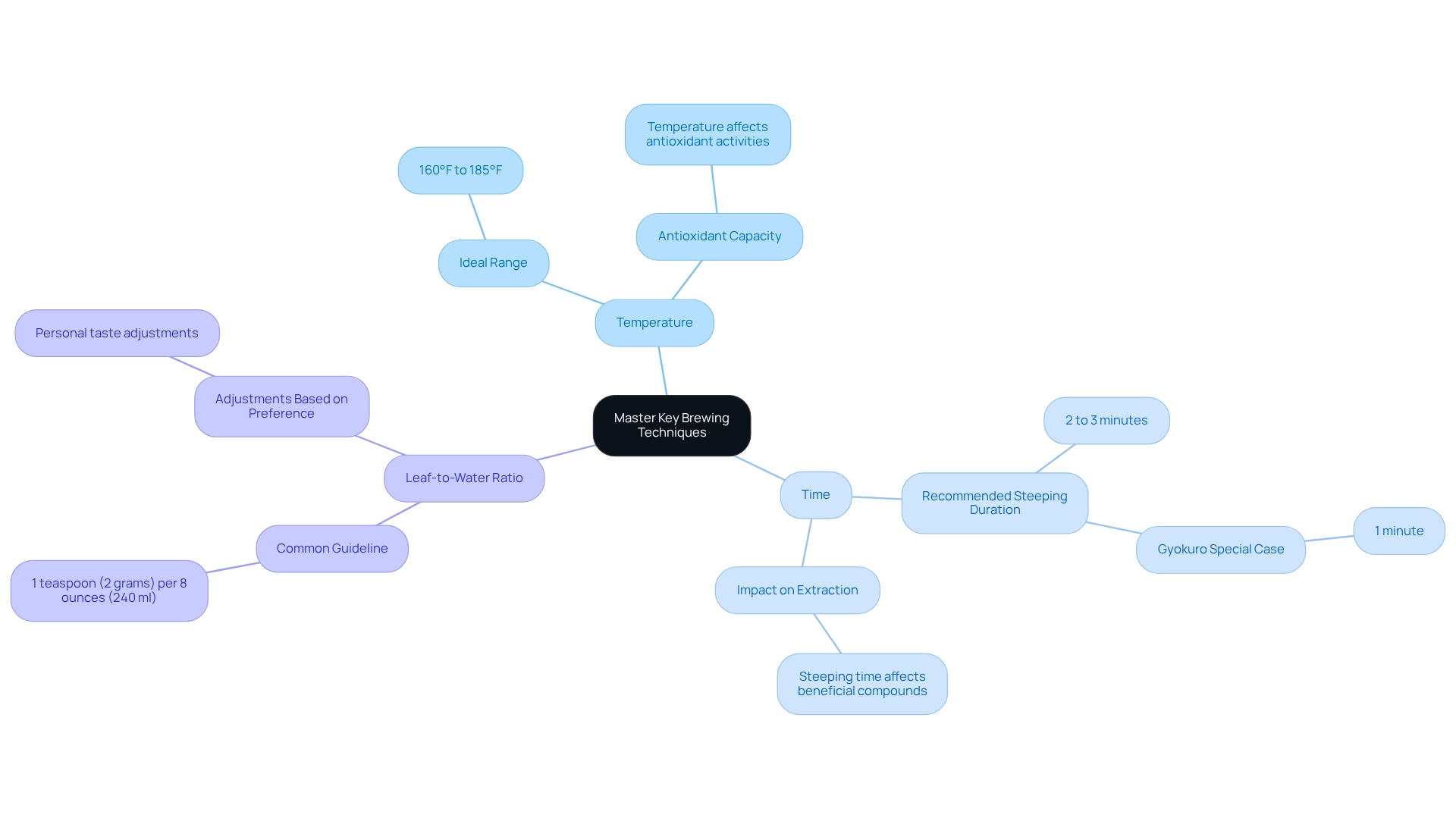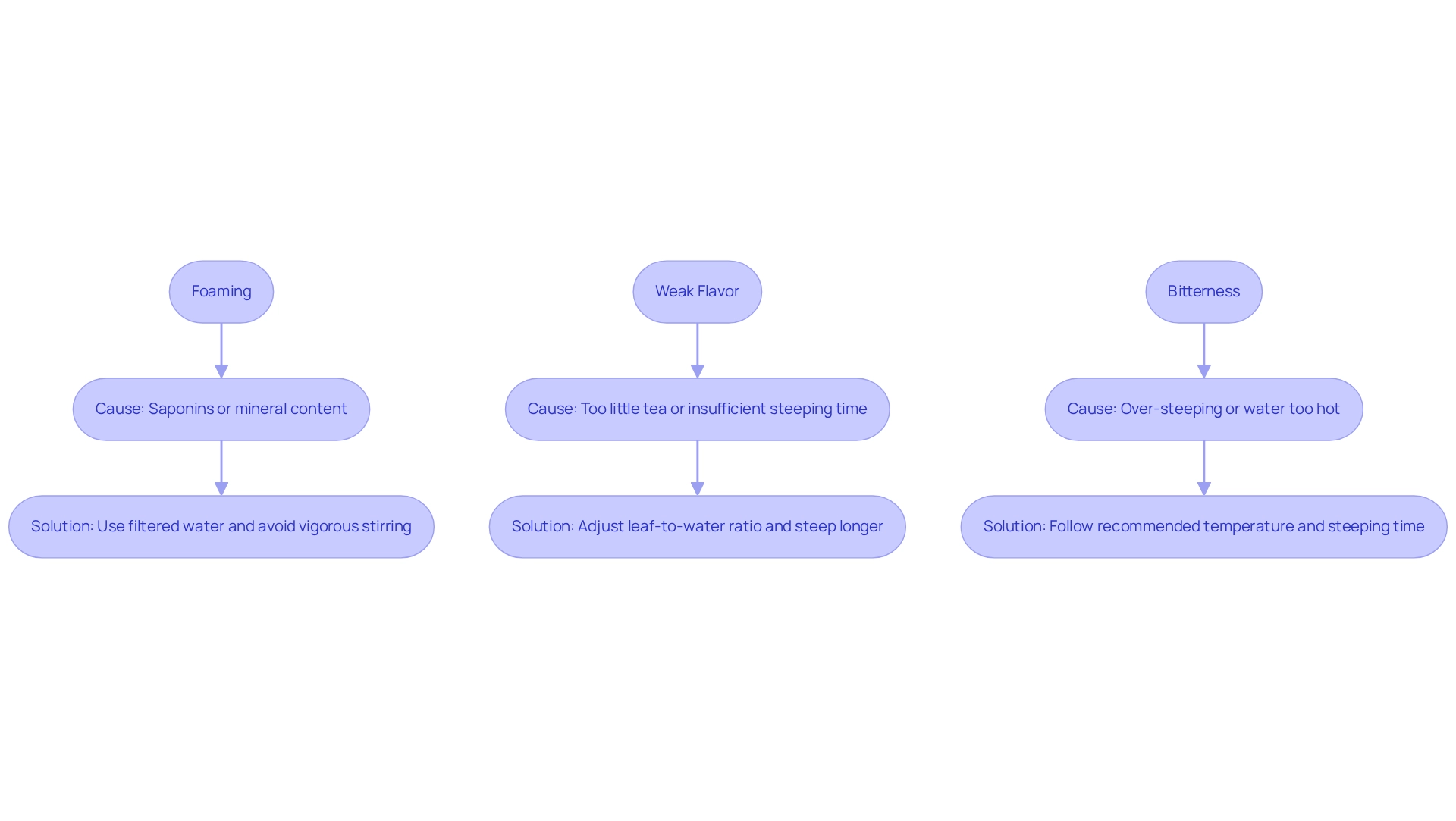Master Loose Green Tea Brewing Techniques for Optimal Flavor

Overview
Mastering the art of brewing loose green tea is a delightful journey that can truly elevate your wellness experience. Understanding the optimal temperature, steeping time, and leaf-to-water ratio is essential to unlock the tea's full flavor potential. Did you know that brewing at temperatures between 160°F and 185°F, and steeping for just 2 to 3 minutes, can significantly enhance not only the taste but also the health benefits of your tea? Research supports these guidelines, revealing how extraction conditions and flavor profiles work together to create a truly enriching experience.
Imagine savoring a cup of tea that not only tastes wonderful but also supports your well-being. By following these simple techniques, you can transform your tea-drinking ritual into a nurturing practice. So why not take a moment to explore these brewing methods? Your journey to a more flavorful and healthful tea experience awaits!
Introduction
In the world of loose green tea, a delightful journey awaits those who are eager to explore its diverse varieties and the art of brewing. Each type of green tea, from the grassy sweetness of Sencha to the savory complexity of Gyokuro, offers a unique tasting experience that can truly elevate any tea-drinking occasion. But achieving that perfect cup goes beyond simply selecting the right tea; it requires a mastery of essential brewing techniques, a keen attention to quality, and an understanding of common brewing challenges.
As interest in health benefits and premium teas continues to grow, knowing how to choose and brew loose green tea has never been more important. This comprehensive guide delves into the intricacies of loose green tea, equipping you with the knowledge to enhance your tea experience. Together, we will appreciate the rich flavors and aromas each brew has to offer, inviting you to savor the moments that matter most.
Understand Loose Green Tea Varieties and Their Unique Characteristics
Loose green tea includes a delightful array of varieties, each providing unique taste profiles and specific brewing requirements. Sencha, for instance, is cherished for its grassy and sweet notes, making it a favored choice among tea lovers. In contrast, Gyokuro provides a rich umami experience, often described as savory and complex. Dragonwell, known for its nutty essence, presents a charming alternative that appeals to those seeking a distinctive taste experience.
At Gardenika, we are dedicated to ensuring that our loose leaf green beverages not only provide exceptional flavor but also meet the highest standards of quality and sustainability. Our USDA Organic Certification guarantees that our beverages are grown without harmful chemicals, benefiting both your health and the planet. Additionally, our KSA Kosher Certification reflects our unwavering commitment to quality and care throughout the production process.
The taste and aroma of these beverages are significantly influenced by harvest timing and preparation techniques. Research indicates that harvesting at the right moment can enhance specific flavor traits, with leaves picked at optimal times showcasing remarkable taste profiles. For instance, studies have shown that higher chlorophyll levels correlate with improved color quality in green beverages, with certain varieties like Fuyun 6 demonstrating outstanding results. Furthermore, the average relative content of β-damascone in summer brews is 2.40 μg/L, which enriches the aromatic qualities of these beverages.
Understanding these distinctions is essential for selecting the perfect tea to suit your personal preferences. Recent trends in the tea industry reveal a growing interest in the health benefits associated with various types of loose green tea, including their potential to aid digestion and promote overall wellness. At Gardenika, every batch of our brews undergoes third-party lab testing to guarantee safety and quality, allowing you to trust that each sip is pure and reliable. Our clients have praised our beverages, stating, "Gardenika's Sencha is the finest I've ever experienced!" By familiarizing yourself with these varieties, you can enrich your tea-drinking experience and fully appreciate the intricate nuances each brew has to offer.

Master Key Brewing Techniques: Temperature, Time, and Leaf-to-Water Ratio
To brew the perfect cup of loose green tea, concentrate on three essential factors: temperature, time, and leaf-to-water ratio.
Temperature: The ideal steeping temperature for most green teas falls between 160°F and 185°F (70°C to 85°C). Water that is too hot can scorch the delicate leaves, leading to a bitter flavor profile. Recent studies suggest that the antioxidant capacity of green tea infusions is significantly affected by preparation temperature, emphasizing the importance of maintaining this range for optimal health benefits. A study monitored the antioxidant capacity of green tea infusions brewed at low (60 °C) and high (95 °C) temperatures, revealing that antioxidant activities were more dependent on brewing temperature than time.
Time: Steeping time is crucial and varies by tea type. Generally, a steeping duration of 2 to 3 minutes is recommended. For more delicate types, such as Gyokuro, a shorter steeping time of just 1 minute is ideal to maintain its subtle nuances and health benefits. Research has shown that steeping times directly affect the extraction of beneficial compounds, making it essential to adhere to these guidelines.
Leaf-to-Water Ratio: A common guideline is to use 1 teaspoon (about 2 grams) of loose green tea per 8 ounces (240 ml) of water. This ratio can be adjusted based on personal taste preferences and the specific type of green tea being brewed. Grasping the connection between the quantity of tea and water can improve the overall taste and health advantages of your brew.
By mastering these preparation techniques, you can unlock the full flavor potential of your green tea while maximizing its health benefits. Consumer preferences suggest that matching preparation methods with optimal extraction conditions can greatly improve the tea-drinking experience, rendering education on these techniques essential. The research named 'Consumer Preferences in Tea Preparation' examined how consumer-favored preparation methods frequently matched optimal extraction conditions, indicating that knowledge on preparation techniques could improve the health benefits of tea.

Select High-Quality Loose Leaf Tea and Proper Brewing Equipment
Selecting high-quality loose green tea blends is essential for an outstanding brewing experience, especially as many have turned to home brewing during the pandemic, which has increased the demand for premium varieties. At Gardenika, we genuinely care about your tea journey, prioritizing beverages that are USDA Organic certified. This ensures they meet rigorous standards for purity and sustainability, allowing you to enjoy your tea with peace of mind. Our commitment to quality is further reflected in our KSA Kosher certification, which guarantees adherence to strict kosher laws. Moreover, every batch of our infusions undergoes third-party lab testing for safety and quality, so you can trust that each sip is pure and dependable. Freshness is key; we encourage you to choose teas that have been recently harvested and packaged to capture their full taste potential.
Investing in quality brewing equipment can significantly enhance your tea experience. A well-designed teapot or infuser allows the leaves to expand fully, releasing their rich essence. We especially recommend glass or ceramic teapots, as they do not impart any undesirable tastes to the tea. To achieve optimal preparation conditions, consider using a digital thermometer to monitor water temperature and a scale for precise measurements of tea leaves.
As Mackenzie Bailey, a marketing expert in the tea sector, emphasizes, clients truly appreciate the significance of quality and organic certification in tea selection. By focusing on both the quality of your loose green tea, such as those offered by Gardenika, and the equipment you use, you can greatly enhance your steeping outcomes and savor the complete range of flavors that premium loose green tea presents. Additionally, be mindful of common mistakes in choosing loose green tea or preparation tools to ensure a fulfilling tea experience. Why not explore our offerings and discover the delightful world of quality tea for yourself?
Troubleshoot Common Brewing Issues: Foaming, Weak Flavor, and More
Even seasoned tea drinkers may encounter challenges when preparing loose green tea. It's perfectly normal to face a few hurdles, and understanding them can enhance your experience. Let’s explore some common issues and their effective solutions:
-
Foaming: If you notice foam, it might be due to saponins in the tea or the mineral content of your water. To minimize foaming, try using filtered water and avoid vigorous stirring during preparation.
-
Weak Flavor: A lackluster brew can stem from using too little tea or not steeping long enough. To achieve the best flavor, ensure you're using the right leaf-to-water ratio and steeping for the recommended time. If it still tastes weak, consider increasing the amount of tea leaves. It's fascinating to note that studies have identified 131 volatiles in black tea infusions, showcasing the complexity of tea flavors and the importance of proper brewing techniques.
-
Bitterness: Bitterness may arise from over-steeping or using water that's too hot. To prevent this, always adhere to the recommended temperature and steeping time for your specific tea variety. Research on tea sensory data has shown significant variations in sensory characteristics based on water type, emphasizing how preparation methods can influence tea quality.
By addressing these common preparation challenges, you can consistently enjoy a delightful cup of loose green tea, which will enhance your overall tea-drinking pleasure. Mastering proper brewing techniques not only elevates flavor but also significantly boosts the health benefits of tea. Therefore, it's essential to troubleshoot these issues effectively. As tea professionals often remind us, grasping these nuances can lead to a more fulfilling tea experience. So, why not take a moment to reflect on your brewing habits and explore the wonderful world of tea with renewed enthusiasm?

Conclusion
Exploring the world of loose green tea opens up a delightful array of flavors and aromas, each variety presenting its own unique characteristics. Imagine savoring the grassy sweetness of Sencha or the umami depth of Gyokuro—understanding these differences is essential for any tea enthusiast. Choosing USDA Organic certified teas not only guarantees superior taste but also supports your health and the environment. By familiarizing yourself with the distinct profiles and proper brewing techniques, you can truly elevate your tea-drinking experience.
Mastering key brewing techniques—like temperature, time, and leaf-to-water ratio—is vital for unlocking the full potential of green tea. Each of these factors plays a crucial role in extracting the delicate flavors and health benefits these teas offer. By following the recommended guidelines, you can avoid common pitfalls and consistently brew the perfect cup.
Investing in high-quality loose leaf tea and the right brewing equipment can further enhance your experience. Prioritizing freshness and quality significantly influences flavor. Additionally, being aware of common brewing challenges allows you to troubleshoot effectively, ensuring that each cup is consistently enjoyable.
Ultimately, your journey into loose green tea is not just about drinking; it’s about savoring moments and appreciating the intricate craftsmanship behind each brew. Embrace these practices and knowledge, and transform your tea time into a delightful ritual that celebrates flavor, wellness, and connection. Why not take the next step and explore the wonderful world of loose green tea today?
Frequently Asked Questions
What are some popular varieties of loose green tea?
Some popular varieties of loose green tea include Sencha, Gyokuro, and Dragonwell. Sencha is known for its grassy and sweet notes, Gyokuro offers a rich umami experience, and Dragonwell is recognized for its nutty essence.
How does Gardenika ensure the quality of its loose leaf green tea?
Gardenika ensures the quality of its loose leaf green tea through USDA Organic Certification, which guarantees that the teas are grown without harmful chemicals. Additionally, they have KSA Kosher Certification, reflecting their commitment to quality and care throughout the production process.
What factors influence the taste and aroma of loose green tea?
The taste and aroma of loose green tea are significantly influenced by harvest timing and preparation techniques. Harvesting at the right moment enhances specific flavor traits, and studies indicate that chlorophyll levels and the content of certain compounds, like β-damascone, can enrich the quality and aroma of the beverages.
What health benefits are associated with loose green tea?
Recent trends indicate that loose green tea may aid digestion and promote overall wellness, contributing to its growing popularity in the tea industry.
How does Gardenika ensure the safety and quality of its tea products?
Gardenika guarantees the safety and quality of its tea products by conducting third-party lab testing on every batch, ensuring that each sip is pure and reliable.
What do customers say about Gardenika's loose green tea?
Customers have praised Gardenika's loose green tea, with comments such as, "Gardenika's Sencha is the finest I've ever experienced!"
Where can I explore Gardenika's loose green tea offerings?
You can explore Gardenika's premium loose herbal infusions and enhance your wellness journey by visiting their shop here.




